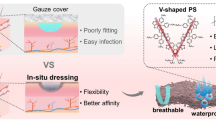Abstract
Reduction-responsive monoolein (MO) cubosome was prepared for the dermal delivery of epidermal growth factor (EGF) by including cystamine-crosslinked alginate in the water channel of the cubosome. On atomic force micrograph, the cubosome was found as round particles and it was tens of nanometers in diameter. Additives such as alginate, cystamine, and EGF seemed to have little effect on the size and the shape of cubosome. The release of EGF from the cubosome was promoted by dithiothreitol (DTT, a reducing agent), possibly because the disulfide bond of the cross-linker (cystamine) might be broken by the reducing agent. The cubosome promoted the permeation of EGF through an artificial skin mounted on a diffusion cell. Thiazolyl blue tetrazolium bromide (MTT) assay revealed that the cubosome exhibited no marked cellular toxicity after it was incubated with cell (CCD-986sk) for 24 h as long as the concentration was not greater than 20 ug/mL. Free EGF could hardly promote the cell proliferation at all the concentrations tested (0.25 ppm–1 ppm). EGF contained in the cubosome suspension significantly enhanced cell proliferation when EGF concentration was 0.75 and 1 ppm. EGF contained in the cubosome suspension could maintain about 85% of the initial biological activity while it was stored at 25°C for 4 weeks.
Similar content being viewed by others
References
Nagarajan, R. (2002) Molecular packing parameter and surfactant self-assembly: the neglected role of the surfactant tail. Langmuir 18: 31–38.
Razumas, V., Z. Talaikytedot, J. Barauskasa, K. Larsson, Y. Miezis, and T. Nylander (1996) Effects of distearoylphos-phatidylglycerol and lysozyme on the structure of the monoolein-water cubic phase: X-ray diffraction and Raman scattering studies. Chem. Phys. Lipids 84: 123–138.
Shah, J. C., Y. Sadhale, and D. M. Chilukuri (2001) Cubic phase gels as drug delivery systems. Adv. Drug Deliv. Rev. 47: 229–250.
Hyde, S. T. and S. Andersson (1984) A cubic structure consisting of a lipid bilayer forming an infinite periodic minimum surface of the gyroid type in the glycerolmonooleat-water system. Z. Kristallog. Cryst. Mater. 168: 213–220.
Kim, J. C. (2015) Thermo-and UV Photo-Triggerable Monoolein Cubic Phase Bearing Poly (Hydroxyethyl Acrylate-co-Coumaryl Acrylate-co-Octadecyl Acrylate). J. Disper. Sci. Technol. 36: 803–810.
Park, D. B. and J. C. Kim (2017) Effect of tris (hydroxymethyl) aminomethane on the phase behavior of poly (ethylene imine)/cinnamic acid conjugate and the release property of cubic phase containing the conjugate. J. Disper. Sci. Technol. 38: 1381–1387.
Kwon, T. K. and J. C. Kim (2011) Monoolein cubic phase containing acidic proteinoid: pH-dependent release. Drug Dev. Ind. Pharm. 37: 56–61.
Kwon, T. K. and J. C. Kim (2011) pH-Dependent Release from Monoolein Cubic Phase Containing Hydrophobically Modified Chitosan. J. Disper. Sci. Technol. 32: 480–484.
Kim, J. A., D. Park, and J. C. Kim (2018) pH-sensitive self-assembling property of poly (ethyleneimine)/cinnamic acid mixture and its effect on pH-dependent release of monoolein cubic phase. Int. J. Polym. Mater. Po. 67: 438–444.
Lee, M. S. and J. C. Kim (2014) Photo?responsive monoolein cubic phase incorporating hydrophobically modified poly (vinyl alcohol)-coumarin conjugate. Polym. Eng. Sci. 54: 227–233.
Dai, J. and J. C. Kim (2013) Photo responsive monoolein cubic phase containing coumarin-Tween 20 conjugates. Drug Dev. Ind. Pharm. 39: 1457–1463.
Zhang, H. and J. C. Kim (2016) Reduction-responsive monoolein cubic phase containing hydrophobically modified poly (ethylene imine) and dithiodipropionic acid. Colloids Surf. A Physicochem. Eng. Asp. 506: 526–534.
Kwon, K. N. and J. C. Kim (2018) Monoolein cubic phase containing disulfide proteinoid and its reduction-responsive release property. J. Disper. Sci. Technol. 39: 614–622.
Kwon, K. N. and J. C. Kim (2016) Glucose-Responsive Monoolein Cubic Phase Containing Glucose Oxidase. J. Disper. Sci. Technol. 37: 1518–1525.
Park, D., D. Y. Yoon, and J. C. Kim (2018) Monoolein cubic phase including in situ ionically gelled alginate and its salt-responsive release property. J. Disper. Sci. Technol. 39: 18–25.
Kim, T. H., K. N. Kwon, D. S. Yoo, S. J. Lee, C. J. Ma, J. H. Ahn, and J. C. Kim (2018) Monoolein cubic phase containing alginate/cystamine gel for controlled release of epidermal growth factor. J. Disper. Sci. Technol. 40: 119–127.
Caboi, F., T. Nylander, V. Razumas, Z. Talaikyté, M. Monduzzi, and K. Larsson (1997) Structural effects, mobility, and redox behavior of vitamin K1 hosted in the monoolein/water liquid crystalline phases. Langmuir 13: 5476–5483.
Tran, N., X. Mulet, A. M. Hawley, T. M. Hinton, S. T. Mudie, B. W. Muir, E. C. Giakoumatos, L. J. Waddington, N. M. Kirby, and C. J. Drummond (2015) Nanostructure and cytotoxicity of self-assembled monoolein-capric acid lyotropic liquid crystalline nanoparticles. RSC Adv. 5: 26785–26795.
Murgia, S., A. M. Falchi, V. Meli, K. Schillén, V. Lippolis, M. Monduzzi, A. Rosa, J. Schmidt, Y. Talmon, R. Bizzarri, and C. Caltagirone (2015) Cubosome formulations stabilized by a dansyl-conjugated block copolymer for possible nanomedicine applications. Colloids Surf. B Biointerfaces 129: 87–94.
Tanford, C. (1968) Protein denaturation. Adv. Protein Chem. 23: 121–282.
Neurath, H., J. P. Greenstein, F. W. Putnam, and J. A. Erickson (1944) The chemistry of protein denaturation. Chem. Rev. 34: 157–265.
Acknowledgements
This work was supported by the Technological Innovation R&D Program (S2406238) funded by the Small and Medium Business Administration (SMBA, Korea) and Basic Science Research Program through the National Research Foundation of Korea (NRF) funded by the Ministry of Education (No. 2018R1A6A1A03025582).
Author information
Authors and Affiliations
Corresponding author
Additional information
Publisher’s Note
Springer Nature remains neutral with regard to jurisdictional claims in published maps and institutional affiliations.
Rights and permissions
About this article
Cite this article
Kim, T.H., Yoo, D.S. & Kim, JC. In vitro Dermal Delivery of Epidermal Growth Factor Using Redox-responsive Cubosomes. Biotechnol Bioproc E 24, 273–281 (2019). https://doi.org/10.1007/s12257-018-0383-5
Received:
Revised:
Accepted:
Published:
Issue Date:
DOI: https://doi.org/10.1007/s12257-018-0383-5




